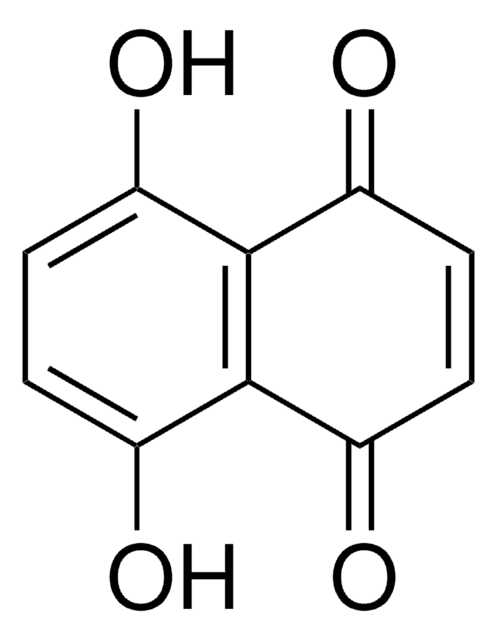추천 제품
product name
2-Hydroxy-1,4-naphthoquinone, 97%
Quality Level
분석
97%
형태
powder
색상
faint yellow to dark yellow, and Faint Orange to Dark Orange
mp
192-195 °C (dec.) (lit.)
λmax
452 nm
응용 분야
diagnostic assay manufacturing
hematology
histology
저장 온도
room temp
SMILES string
OC1=CC(=O)c2ccccc2C1=O
InChI
1S/C10H6O3/c11-8-5-9(12)10(13)7-4-2-1-3-6(7)8/h1-5,12H
InChI key
CSFWPUWCSPOLJW-UHFFFAOYSA-N
유사한 제품을 찾으십니까? 방문 제품 비교 안내
일반 설명
2-Hydroxy-1,4-naphthoquinone is one among the forensic reagents used for fingerprint detection.
2-Hydroxy-1,4-naphthoquinone, produced from Lawsonia inermis, is an orange dye. It belongs to the class of naphthoquinone dyes. 2-Hydroxy-1,4-naphthoquinone is used to dye hair and to color textiles. It has antibacterial, antifungal, anti-inflammatory, antiviral and antineoplastic properties. 2-Hydroxy-1,4-naphthoquinone inhibits tumor cell growth. It stimulates the production of reactive oxygen species (ROS).
애플리케이션
2-Hydroxy-1,4-naphthoquinone has been used as a compound for the culture of schistosome worms.
신호어
Warning
유해 및 위험 성명서
Hazard Classifications
Eye Irrit. 2 - Skin Irrit. 2 - STOT SE 3
표적 기관
Respiratory system
Storage Class Code
11 - Combustible Solids
WGK
WGK 3
Flash Point (°F)
Not applicable
Flash Point (°C)
Not applicable
개인 보호 장비
dust mask type N95 (US), Eyeshields, Gloves
이미 열람한 고객
Fabiola Kind et al.
Journal der Deutschen Dermatologischen Gesellschaft = Journal of the German Society of Dermatology : JDDG, 10(8), 572-578 (2012-02-04)
The increased frequency of case reports of allergic contact dermatitis from non-permanent black henna tattoos in recent years shows the popularity of this form of body painting. Seven patients presented with allergic contact dermatitis after initial hair or eyelash dyeing.
Perry G Wang et al.
Journal of chromatography. B, Analytical technologies in the biomedical and life sciences, 879(20), 1795-1801 (2011-05-25)
A rapid method for the determination of para-phenylenediamine (PPD) in cosmetic products, such as henna tattoos has been developed and evaluated. This analytical procedure involved extracting a 10mg test portion of cosmetic product in 10 mL of ethyl acetate, followed
Emerging latent fingerprint technologies: a review
Bumbrah G, et al.
Research Reports Forensic Med Sci, 6, 39-50 (2016)
Pablo J Almeida et al.
Contact dermatitis, 66(1), 33-37 (2011-10-07)
Very few studies are available in which the components of henna products used by tattoo artists have been analysed. The aim of this study was to quantify the amounts of lawsone (2-hydroxy-1,4-naphthoquinone, the active ingredient in henna) and p-phenylenediamine (PPD)
Francisco L S Bustamante et al.
Inorganic chemistry, 52(3), 1167-1169 (2013-01-25)
Dimerization of lawsone occurs upon reaction with Co(BF(4))(2)·6H(2)O and N,N'-bis(pyridin-2-ylmethyl)ethylenediamine (py(2)en) to produce the mononuclear complex [Co(III)(bhnq)(py(2)en)]BF(4)·H(2)O (1). This complex has been investigated as a prototype of a bioreductive prodrug, where the bhnq(2-) ligand acts as a model for cytotoxic
자사의 과학자팀은 생명 과학, 재료 과학, 화학 합성, 크로마토그래피, 분석 및 기타 많은 영역을 포함한 모든 과학 분야에 경험이 있습니다..
고객지원팀으로 연락바랍니다.













